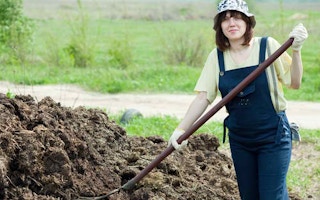All sorts of clever, expensive and downright daft ideas for removing carbon from the atmosphere have been suggested, but one of the simplest and most effective – building up carbon in the soil – hardly rates a mention.
It is a process that happens naturally, but intensive agriculture, deep ploughing, heavy artificial fertiliser use and cutting down forests have impoverished soils worldwide. If the process could be reversed by adding extra organic matter to the soil each year, then the worst effects of climate change could be averted.
Although the issue was hardly raised in the two weeks of negotiations on the Paris Agreement in early December, behind the scenes the way farmers produce crops remains central to knowing whether we can hope to avoid the full impact of the warming climate.
More than 100 of the 196 countries present in Paris which submitted plans beforehand on how to reduce their own carbon emissions put agriculture, forestry and replacing carbon in soils into their programmes.
Better yields
Also, on the fringes of the conference, the CGIAR Consortium, a partnership of leading agricultural research organisations, announced a US$225 million five-year plan to mitigate climate change by putting carbon back into the soil while improving developing world agricultural yields.
This is part of a much longer-running international initiative started by France,the 4% Initiative, which aims to increase the carbon content of soil by four parts per thousand each year, enough to counteract human interference with the climate from the continued burning of fossil fuels.
The CGIAR plan they call “climate-smart agriculture” will help farmers in Ghana, Senegal, Tanzania, Uganda, Vietnam, Nepal and Colombia. The aim is to disturb soils as little as possible, using zero tillage techniques, encouraging 10 per cent tree cover and better management of rangelands. All of these methods increase yields, return carbon to the soil and help retain moisture.
According to CGIAR: “Soil is a massive carbon reservoir, containing two to three times as much carbon as the atmosphere. Increasing soil carbon by 0.4 per cent per year would offset atmospheric carbon emissions.
“Increasing soil carbon not only mitigates climate change, it also would increase – or restore – soil health and fertility, thereby helping agriculture to adapt to climate change and improve environmental health overall.”
One of the key organisations supporting the 4 per1000 initiative is Organics International (IFOAM), the international organic farming organisation that has 800 members in 125 countries. The president, André Leu, is a tropical fruit farmer in Australia who says that food security and carbon sequestration in the soil are central to saving the planet from the extreme impacts of climate change.
“It does not matter which part of the world you are in and what you grow. Putting carbon back into the soil, increasing the organic matter, is essential to improving yields in the long run,” he said.
“If we are to combat droughts then organic matter retains moisture as well as carbon, so we make soils more resilient and productive. Organic agriculture used to be ridiculed for a long time but now science backs us as a solution to climate change. We want to share our knowledge so that many farmers and consumers across the world can benefit.”

















